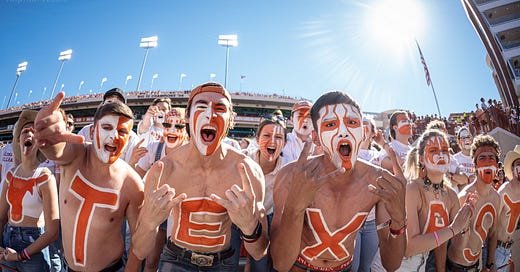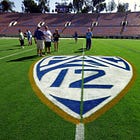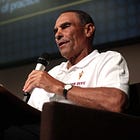
The college football offseason is finally drawing to a close, making it time to turn our attention to the field. But the field sure does look different, doesn’t it? Almost like that conference logo on the 25 yardline doesn’t look like it had in the past.
Conference realignment was all the rage in the past few years, but now it’s actually here. All these seismic moves that have reshaped the face of college sports have now come to fruition. The moves have been completed. But what does that look like for each conference? Let’s break it down one-by-one to see who’s in and who’s out from each FBS conference.
Required Reading:
ACC
In: Stanford, Cal, SMU
Out: None
The ACC played one of the strangest roles in realignment - and will be the next domino to fall. Florida State and Clemson are reportedly already looking for a way out, but this article isn’t about future realignment. It’s about what we can expect in 2024.
The ACC’s first move was to add two PAC-12 schools: Stanford and Cal. They fit the academic profile well, meshing with private powerhouses like Duke, North Carolina-Chapel Hill, and Syracuse. But athletically? The ball drops there for football, at least.
Neither school has really amounted to much recently in the PAC-12, and that’s not likely to change when they join the ACC. I expect both to settle in as mid-tier ACC schools. Perhaps one could surprise us (my money is on Stanford being the better of the two), but it’s just not likely.
The conference’s later addition, though, has more intrigue. SMU, famous for the death penalty and banned boosters, is back. Mustang boosters are footing their bill for seven years(!), earning no media rights from their move to the Power Four. With pay-for-play back on the menu, it’s time for SMU to flex their muscles and return the Mustangs to glory.
And that might no be as far away as you’d think. SMU was a quality team last year, going 11-3 with a 26-14 American Conference Championship over Tulane. They did fall in the Wasabi Fenway Bowl to new ACC foe Boston College, 23-14. The Ponies finished the season ranked 22nd in the final AP Poll. With a ton of returning production, including quarterback Preston Stone, SMU could surprise a lot of people and be competitive in the ACC from Year 1.
Big 10
In: Oregon, USC, UCLA, Washington
Out: None
The USC-UCLA move to the Big 10 was really the catalyst that this was all real and everything was changing. But three years later, and with two other PAC-12 friends, it’s finally here.
In all reality, Oregon and USC provide the best immediate programs for the conference. ESPN’s FPI puts Oregon as the best team in the conference and Number 2 overall. That ahead of the reigning champions Michigan (12) and Ohio State (4). FPI give the Ducks a 12.8 percent chance to win the title. Dan Lanning has built a strong program in Eugene that immediately becomes one of the Big 10’s best.
USC, on the other hand, was supposed to be the next big thing in the PAC-12 after hiring Lincoln Riley. And that’s been true. Kind of. Caleb Williams was legit, but Alex Grinch stole any goodwill here. Now, with the hire of UCLA’s D’Anton Lynn, the Trojans should be better on that side of the ball. Riley will always make a powerful offense, but he needs a defense to make only a few stops. Especially in a strong defensive conference like the Big 10.
UCLA was a defense first team, but had head coach Chip Kelly poached by Ohio State and Lynn by USC. Now, first year head coach DeShaun Foster, who was associate head coach and running backs coach a year ago, will lead a program light on recruits into one of the nation’s toughest conferences. It’ll likely be a couple of years before UCLA is able to compete, if at all.
The final addition, Washington, looks a lot different than before. The crux of their offense - head coach Kalen deBoer, offensive coordinator Ryan Grubb, quarterback Michael Penix Jr., wide receivers Rome Odunze, Ja’Lynn Polk, and Jalen McMillan, offensive lineman Troy Fautanu - are all gone. They’ve got a new head coach in Jedd Fisch, who resurrected Arizona the past few years, and a shiny new quarterback in Will Rogers. Rogers and Fisch seem like a perfect match, but can the rest of the Huskies, led by running back Dillon Johnson, keep Washington competitive?
Big 12
In: Arizona, Arizona State, Colorado, Utah
Out: None
Heading into this realignment cycle, the Big 12 was seen as the weakest link of the Power Five and primed for poaching. Then, they made their best decision: hiring Brett Yormark. Since then, Yormark has stabilized the volatile conference and positioned it as the third best in football and clear-cut top conference in men’s basketball. Ahead of last season, he added BYU, Cincinnati, Houston and UCF. Now, he adds four more brands.
For football fans, the headliner here is possibly not who it should be. While Utah jumps in as an immediate conference contender, all eyes are on Boulder, Colorado and Coach Prime’s Buffaloes. Colorado has been the talk of the college football town since the hiring of Deion Sanders, and many believe he’s geared up to give his son, quarterback Shedeur Sanders, a Heisman run. Still, the Buffs limped to a 4-8 record in 2023. With a downgrade in playcaller from Sean Lewis to Pat Shurmur and a still very questionable offensive line, can Colorado improve?
Utah, as stated, brings immediate conference contender. They’ve competed in the PAC-12 each year, and their home stadium, Rice-Eccles, is one of the hardest to win in across the nation. With quarterback Cam Rising returning yet again - and earning another year of eligibility after this - the Utes are ready for another run. Plus, having the steady Kyle Whittingham at the helm ensures they’re going to compete.
Arizona and Arizona State are both in interesting situations. Arizona has a new head coach in Brett Brennan after Fisch’s departure, but they retained a ton of pieces , including standout sophomore quarterback Noah Fifita. The team fits Brennan’s up-tempo air raid style and has their eyes set on a bowl win and more. Arizona State, however, is on NCAA Probation and building from the ground up after a disastrous Herm Edwards tenure. Kenny Dillingham has his work cut out for him, but the Sun Devils’ 3-9 record last year can be deceiving after four quarterbacks started following a bevy on injuries at the position. Let’s see how they look with stability across the offense in 2024, but a bowl is their ultimate goal this season.
Required Reading:
SEC
This is the one that started it all. The seismic move that reshaped college football and started the domino effect that led to this article. Oklahoma and Texas to the SEC.
If you’re going to add two programs, these are the ones. Oklahoma has gotten more balanced and tougher under Brent Venables than in the Riley era. Dillon Gabriel may be gone to Oregon, but Jackson Arnold has tons of talent and may end up being even better than Gabriel. Plus, add in any Venables-led defense and you get a contender immediately. There was a moment last season where Oklahoma may have been the best team in the nation following their 34-30 win in the Red River Shootout over then-No. 3 Texas. Let’s see if they can build on that this year in a much tougher SEC.
The other addition may be the better of the two, despite historical records. Without a doubt, Texas is back. Head coach Steve Sarkisian has built what ESPN’s FPI calls the third best team in the nation. Texas is one of four teams with at least 10 percent chance to win the national championship, per the FPI metrics, and it’s easy to see why. With quarterback Quinn Ewers returning after lighting college football on fire for a few weeks in 2023 and Sark back at the helm, the Longhorns will be dangerous. The main question I have for Texas is who is going to step up in the receiving game? With their top five receivers from a year ago now in the NFL, there’s a lot of production to replace.
PAC-12
In: None
Out: Arizona, Arizona State, Colorado, Cal, Oregon, Stanford, UCLA, USC, Washington
I’ve written a lot about the death of the PAC-12. Just check the first Required Reading section for some real-time thoughts about the conference’s demise.
So, we’re left with two: Oregon State and Washington State. Both have been nearly relegated to the Mountain West, signing a scheduling deal with the conference for the 2024 season.
Oregon State was gutted when they were left behind. Head coach Jonathan Smith? Gone. Starting quarterback D.J. Uiagalelei? Gone. Promising young quarterback Aiden Chiles? Gone with Smith. A promising team that provided tons of fun in the PAC-12 was ruthlessly decimated. Now, they will compete for a championship that doesn’t exist.
Washington State, on the other hand, was just starting to build. They lost quarterback Cam Ward first to the transfer portal, then to the NFL, and then again to the portal when he enrolled at Miami. After a 5-7 season landed them at the bottom of the final iteration of the PAC-12 for the time being, they’ll battle for a bowl bid amid a sea of Mountain West competition.
American
In: Army
Out: None
Now, onto the Group of Five.
The American’s biggest move this offseason wasn’t realignment. Instead, it was commissioner Mike Aresco passing the torch to Tim Pernetti. Aresco oversaw the conference’s survival in the face of the Big East’s demise in the 2013-14 realignment cycle and built them into one of the strongest Group of Five conferences, even pushing the moniker “Power Six” when Scott Frost’s UCF went undefeated with a Cotton Bowl with over Georgia and claimed a national title and when Luke Fickell’s Cincinnati earned the first ever playoff bid for a G5 team.
On the realignment side, the move to add Army just made sense. The Black Knights of West Point were already playing an American-heavy schedule as an independent. Army-Navy will stay a non-conference game, even with the two sharing a home in the American. But what’s more American than two service academies running the triple option in the same conference?
Conference USA
In: Kennesaw State
Out: None
Conference USA was poached heavily by the Sun Belt and American following the Power Five moves, and their growth approach has taken a few years. Last year, we saw Liberty and New Mexico State renege their independent status to join the conference while adding quality FCS programs in Sam Houston and Jacksonville State.
This year, the only newcomer is Kennesaw State, previously of the ASun. The Owls played an abbreviated 9-game schedule as FCS independents in 2023 ahead of their transition, going 3-6. However, they did sign their highest ever recruiting class by 247Sports’ metrics in the most recent early signing period, inking four-star linebacker Donovan Westmoreland, the school’s highest rated recruit.
CUSA is also adding two more FCS programs for 2025: Delaware and Missouri State.
MAC
In: None
Out: None
The MAC shocked everyone and added UMass for the 2025 season. The Minutemen are no stranger to the conference as a football-only affiliate member from 2012-15. UMass will remain an FBS independent for 2024 while the rest of its sports finish out their time in the Atlantic 10.
Mountain West
In: None
Out: None
The Mountain West is standing pat, aside from their scheduling agreement with Oregon State and Washington State. And that’s for the best with them. There aren’t a lot of school west of the Mississippi clamoring to join the FBS ranks, especially as the Big Sky dominates the FCS.
Sun Belt
In: None
Out: None
The Sun Belt hopped on the realignment train quickly, adding Marshall, Southern Miss, and Old Dominion from CUSA and James Madison from FCS Colonial Athletic Association in 2022. Since then, the conference has not really come up in realignment talks and seems to be good with its current 14 members.
Have any questions, ideas, article pitches, or information? With the new Substack features, you can directly message me! Hit the button below to send me a message, or reach out via email to sidsports23@gmail.com, or find us on your favorite social media platform like Facebook, Instagram, Twitter, Substack Notes and Bluesky.









